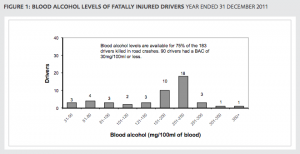How many deaths would be prevented by lowering the blood alcohol limit to 0.08%?
Well, obviously, none. The limit is already 0.08%.
However, there are still deaths caused by people who drive over the limit. From crash data for drivers only, in 2011, there were a lot more crashes where the driver was above 0.08% than between 0.05% and 0.08%, and a larger fraction of these will have been caused by alcohol rather than just being coincident with alcohol.
Just as lowering the limit 0.08% prevented some, but not all, crashes where the drivers were above 0.08%, lowering the limit to 0.05% would prevent some, but not all, crashes where the driver is above 0.05%.
Alcohol Healthwatch director Rebecca Williams said the statistics clearly showed 20 people would still be alive if the Government had responded to calls for a lower alcohol limit.
which seems completely indefensible.
I don’t have any personal stake in the 0.08% limit — I don’t have a car and can afford taxis. And I’m not denying the real dangers of drink driving: according to estimates from NZ data the risk at 0.08% is about three times that at 0.05%. But it’s dishonest to assume that all deaths where the driver was over 0.05% would be eliminated by the change, and to pretend there are no costs from the change. We should be arguing this using the best available estimates of the benefits and costs.
And if you think the costs are irrelevant because there’s no limit on the value of a life, what about all the other ways to save lives? There are plenty of competing options, even if you think it’s only New Zealand lives that are valuable.
Thomas Lumley (@tslumley) is Professor of Biostatistics at the University of Auckland. His research interests include semiparametric models, survey sampling, statistical computing, foundations of statistics, and whatever methodological problems his medical collaborators come up with. He also blogs at Biased and Inefficient See all posts by Thomas Lumley »

I would have thought that the major argument here is not about where on the distribution the threshold is set, but instead will lowering the threshold in itself *shift* the entire distribution? If as you say, the tolerance is lowered but the distribution is unchanged, then not much good is achieved. But is it likely that by lowering the tolerance, will more people avoid drinking and driving at all because of worrying about getting caught out?
This is unlikely to change the behaviour of people who drink well over the limit. So paradoxically, lowering the tolerance could increase the mean alcohol level of people involved in accidents, as a side effect of reducing the total number of drink drivers, mainly by reducing the number of people at the lower tail of the distribution.
Is there evidence for that from other countries? I don’t know.
12 years ago
That would be a more sensible discussion to have, but it’s not the one the Herald is interested in having.
12 years ago